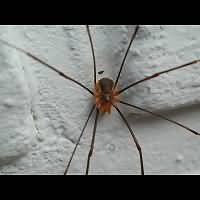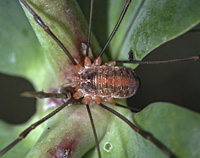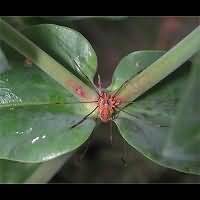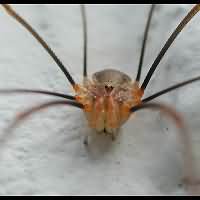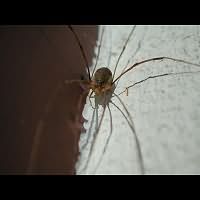Red Harvestman Opilio canestrinii
The Red Harvestman is a credit to its name, for it is orangereddish brown. Yet this doesn't make him to be unique. There are two similar species: Opilio saxatilis and the Wall Harvestman (Opilio parietinus). Usually the Red Harvestman is easily identified. There is a big contrast between the reddish body and the very dark legs. In the other species the legs are lighter. Thus the contrast between body and legs is less striking. All this is true for the males only. The females have a yellowish brown or ochreous brown ground color. The leggs are ringed with very big vague rings. This is best seen in the females though. The male body reaches a length of some 4 to 6mm. The females, reaching a bodily length of 5 to 8mm, are much bigger.
The female lays her eggs in summer and autumn. They are being laid in soft, moist soil in small groups. After overwintering they hatch in early spring. The young go through 7 stages (nowadays often refer to as 'instars') before becoming adult. During the first instars their legs are very short indeed and they give the impression of being a mite rather than a harvestman. Like most other harvestmen the Red Harvestman rests during the day and hunts for small insects and other harvestmen at night.
Some 30 years ago the Red Harvestman was only found in the Apennines. Then it was imported into Central Europe, some way or another. Most likely by transporting soil containing eggs. From that moment the Red Harvestman has invaded other parts of Europe in an amazing speed! The route is rather peculiar, for the animal was seen in Denmark by 1987. In Sweden it was first seen in 1990. But it took till 1993 for the animal to reach Holland. England has been invaded from 1999. But once arrived the spreading is extremely quick. The two species present at walls at that moment (Opilio saxatilis and the Wall Harvestman) are completely wiped out. Both species are extremely rare in areas where The Red Harvestman lives. And in some places both species are completely extinct. The Red Harvestman is always found near people's homes and gardens. It is rarely found in vegetation. This species hasn't invaded all of Britain yet, but it will reach the last corners of the British Isles in the next couple of years.
The Red Harvestman is a credit to its name, for it is orangereddish brown. Yet this doesn't make him to be unique. There are two similar species: Opilio saxatilis and the Wall Harvestman (Opilio parietinus). Usually the Red Harvestman is easily identified. There is a big contrast between the reddish body and the very dark legs. In the other species the legs are lighter. Thus the contrast between body and legs is less striking. All this is true for the males only. The females have a yellowish brown or ochreous brown ground color. The leggs are ringed with very big vague rings. This is best seen in the females though. The male body reaches a length of some 4 to 6mm. The females, reaching a bodily length of 5 to 8mm, are much bigger.
The female lays her eggs in summer and autumn. They are being laid in soft, moist soil in small groups. After overwintering they hatch in early spring. The young go through 7 stages (nowadays often refer to as 'instars') before becoming adult. During the first instars their legs are very short indeed and they give the impression of being a mite rather than a harvestman. Like most other harvestmen the Red Harvestman rests during the day and hunts for small insects and other harvestmen at night.
Some 30 years ago the Red Harvestman was only found in the Apennines. Then it was imported into Central Europe, some way or another. Most likely by transporting soil containing eggs. From that moment the Red Harvestman has invaded other parts of Europe in an amazing speed! The route is rather peculiar, for the animal was seen in Denmark by 1987. In Sweden it was first seen in 1990. But it took till 1993 for the animal to reach Holland. England has been invaded from 1999. But once arrived the spreading is extremely quick. The two species present at walls at that moment (Opilio saxatilis and the Wall Harvestman) are completely wiped out. Both species are extremely rare in areas where The Red Harvestman lives. And in some places both species are completely extinct. The Red Harvestman is always found near people's homes and gardens. It is rarely found in vegetation. This species hasn't invaded all of Britain yet, but it will reach the last corners of the British Isles in the next couple of years.

